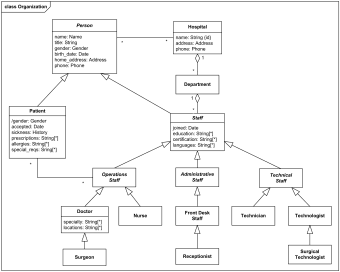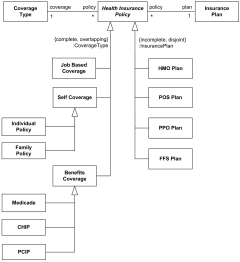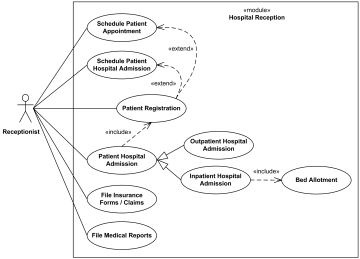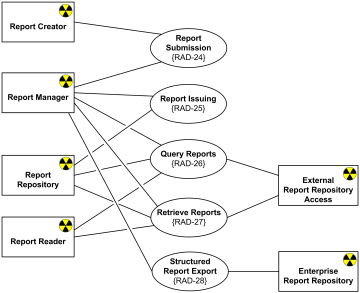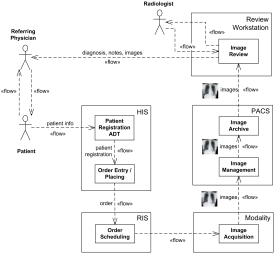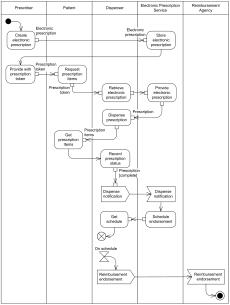Hospital Management
UML Diagram Examples
Here we provide several UML diagrams of different types, all part of a Hospital Management model.
Purpose: Domain model for a hospital to show and explain hospital structure, staff, relationships with patients, and patient treatment terminology.
Summary: The domain model for the Hospital Management System is represented by several class diagrams.
Ward is a division of a hospital or a suite of rooms shared by patients who need a similar kind of care. In a hospital, there are a number of wards, each of which may be empty or have on it one or more patients. Each ward has a unique name.
The doctors in the hospital are organised into teams (also called firms). Each team has a unique name or code (e.g. Orthopaedics or Pediatrics) and is headed by a consultant doctor or an attending physician.
Purpose: Domain model describing various types of health insurance policies.
Summary: This example shows several subtypes of Health Insurance Policy using UML generalization sets. One generalization set is Coverage Type - Job Based Coverage, Self Coverage, and Benefits Coverage, and another set is based on Insurance Plan - HMO, POS, PPO, FFS.
Purpose: Describe major services (functionality) provided by a hospital's reception.
Summary: Hospital Management System is a large system including several subsystems or modules providing variety of functions. Hospital Reception subsystem or module supports some of the many job duties of hospital receptionist. Receptionist schedules patient's appointments and admission to the hospital, collects information from patient upon patient's arrival and/or by phone.
For the patient that will stay in the hospital ("inpatient") she or he should have a bed allotted in a ward. Receptionists might also receive patient's payments, record them in a database and provide receipts, file insurance claims and medical reports.
Purpose: Radiology diagnostic reporting UML use case diagram example for Simple Image and Numeric Report (SINR) IHE Radiology Integration Profile.
Summary: In the initial stage of diagnostic reporting, a reading physician records a diagnosis by generating a draft DICOM Structured Report (SR) object. Report Creator actor transmits that DICOM SR object to the Report Manager. External Report Repository Access actor is a gateway to obtain other enterprise department reports, such as Laboratory and Pathology, from within the Imaging department.
Purpose: Show information flow associated with radiology exams and including patient registration, ordering radiology exam, exam scheduling, acquisition of images, image storage and viewing activities.
Summary: Information flow diagrams are auxiliary UML 2.x diagrams which could be used to describe circulation of information in a system in a general manner. This example shows simplified information flow based on Scheduled Workflow Integration Profile from IHE Radiology Technical Framework.
Scheduled Workflow (SWF) integrates the ordering, scheduling, imaging acquisition, storage and viewing activities associated with radiology exams.
Purpose: Electronic prescriptions UML activity diagram example is based on documentation for the Electronic Prescription Service (EPS) R2 developed by the NHS Connecting for Health (NHS CFH) in England.
Summary: Prescribers could send prescriptions electronically to a pharmacy of the patient's choice where patient can pick it up. Dispenser retrieves electronic prescriptions from the EPS.
